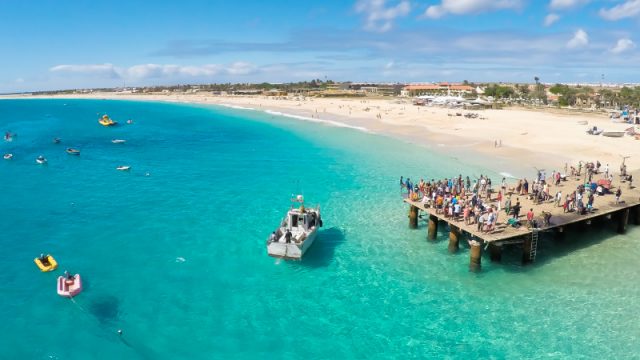Did you know that the archipelago known as the Cape Verde Islands, located off the west coast of sister nation Guinea-Bissau, was uninhabited until the late 1400s? That it is only slightly larger than the state of Rhode Island? And that it gained independence from Portugal on July 5, 1975? Here are 15 things you might not know about Cape Verde’s history and culture, pre- and post-colonization.
1. It was uninhabited upon discovery
When explorers first discovered the Cape Verde islands in 1456, they were uninhabited. In 1495 Portugal claimed the islands, which remained under their control for another 450-plus years. Today, the majority of residents are a mix of Portuguese and African.
2. It was wealthy during the time of the slave trade
Its position on the great trade routes between Africa, Europe and the New World made Cape Verde an ideal and very rich slave trade center. However after the slave trade was abolished in 1876, the islands began to decline economically. In the 20th century, much of its economy has been driven by the shipping industry.
3. It split from Guinea-Bissau in the 19th century
In 1879 Cape Verde became its own Portuguese territory. Prior to this it had a long-standing joint colonial administration with mainland neighbor Guinea-Bissau.
4. It had another status change in the 20th century
Amid the contemporary African decolonization movement, Cape Verde’s status was modified in 1951 to “overseas provinces,” and its inhabitants were officially granted full Portuguese citizenship in 1961.
5. Not everyone was happy about these changes
Not perceiving these changes as worthwhile, however, some members of the colonial populations of both Guinea-Bissau and Cape Verde began to push for complete independence from Portugal.
6. Peaceful independence was pushed for
One such group was the African Party for the Independence of Guinea and Cape Verde (Partido Africano da Independência da Guiné e Cabo Verde; PAIGC). It was founded in Bissau in 1956 and headed by Amílcar Cabral, who was considered a gifted revolutionary leader and theoretician. Its goal was to achieve independence by using peaceful means of protest.
7. A Portuguese coup ultimately led to independence
Portugal began abandoning its colonial empire and negotiating with African national movements after a 1974 coup in which Lisbon installed a new government. This led to Cape Verde’s independence on July 5, 1975.
8. It’s good at getting by
Cape Verde is made up of 10 islands and five islets, all of which are mountainous, and it has few natural resources, little arable land and frequent droughts. Despite all this, it is still one of Africa’s most politically and economically stable countries. It also has some gorgeous beaches — like those pictured above — with serious tourism potential.
9. More Cape Verdeans live off the islands than on them
Thanks to severe droughts throughout much of the 20th-century, many people moved off the island. Today more people with Cape Verdean roots live outside the country than in it. The money they send home, however, brings in much-needed foreign currency. Partly for this reason, Cape Verde enjoys a per capita income greater than many African countries.
10. The UN promotes it
Cape Verde is considered one of the least-developed countries in the world, according to the United Nations, which sponsored a promotion campaign for the islands in 2008. Since then Cape Verde has seen economic growth averaging 6% per year, plus the construction of three international airports and hundreds of kilometers of new paved roads.
11. Charles Darwin visited
The Cape Verde islands were visited by Charles Darwin’s expedition, in 1832 but one of the earliest people to explore them was Sir Francis Drake, who visited centuries before Darwin. Privateers and pirates were the primary visitors until the 20th century.
12. It’s now known as Cabo Verde, for official purposes
In official delegations around the world, such as the UN, this island nation now uses the Portuguese designation “Cabo Verde.” The government decided it would make this change in 2013, even for English speakers.
13. It’s primarily made up of igneous rocks
Due to their volcanic origins and pyroclastic debris, most of the islands are primarily made up of igneous rocks, similar to islands such as Hawaii. The last volcano to erupt in Cape Verde was Fogo in 1995.
14. It’s endangered because of climate change
According to the president of Nauru, Cape Verde is ranked the eight most endangered nation on the planet due to flooding from increasing climate change. The arid areas along the coast and scarce water sources make it prone to erosion.
15. Over 90% of all food is imported
Due to its remote location far from the coast of the African mainland and the fact that only four of the 10 main islands produce significant agricultural products, over 90% of all the food consumed in Cape Verde has to be imported. While the islands can’t grow much food, the volcanic soil is great for wine growing.
Related content on AFKTravel:
Escape To The Islands: 10 Reasons You Should Go To Cape Verde
Culture Corner: The Story of Kriolu, The ‘Unofficial Official’ Language Of Cape Verde
More Than Just Salt: Exploring Sal, Cape Verde’s Tourist Hub
Want to discover the finer side of Africa? Sign up for our weekly newsletter.

